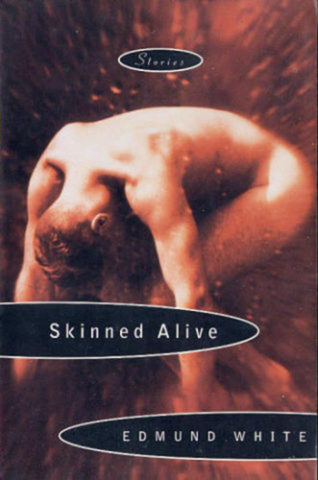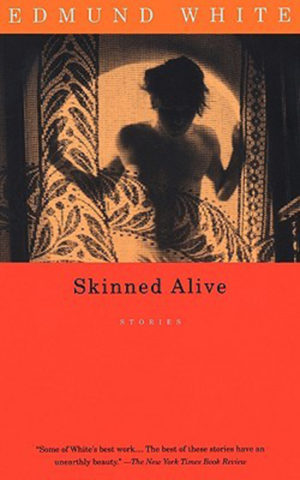 Skinned Alive
Skinned Alive
by Edmund White
Published by Random House
Published 1995
Fiction (autofiction)
273 pgs. • Find on Amazon.com
Reviewed by Stephen O. Murray
March 5, 2017
Although I have been avidly reading Edmund White since the late-1970s, I did not bestir myself to get a copy of his collection of longish stories, Skinned Alive, when it was published in 1995. Three of the eight stories (“Running on Empty,” “The Oracle,” “Palace Days”) had been collected in The Darker Proof together with four by Adam Mars-Jones. I had that book and the Granta in which the title story had appeared. With AIDS burning all around me, I was less than enthusiastic in reading (and, especially, rereading) fiction about facing the prospects of rapid decay and early death.
AIDS is certainly not “over” as gay conservative pundit Andrew Sullivan rashly claims, but, for HIV+ North Americans with access to protease inhibitor drugs, a different epoch began in 1996, so that the panics and grim resignations portrayed in many of White’s stories (and in his two subsequent novels, A Farewell Symphony, The Married Man) and in the collection of memoirs of AIDS casualties among artists he edited, Loss Within Loss are pictures of a vanished world, like reading about the pre-holocaust Jewish ghettoes recalled by Isaac Bashevis Singer or watching movies with European cities in ruins. I don’t mean to imply that timeless human themes are missing, but there is something for historical curiosity, answers to “What was it like?”
I discovered that the four stories in Skinned Alive that I had not read during the late-1980s and early-’90s do not have HIV+ positive characters. The first and last stories in the collection (“Pyrography,” “Watermarked”) are set in earlier times: an adolescent canoeing trip undertaken by three suburban Chicago boys in the first and a tale of generally frustrated love for an actor, with whom the narrator moves from the University of Michigan to Manhattan, in the last. I don’t know whether the first is autobiographical in any specific sense (and I wonder about portaging an outboard motor and gasoline for it…). From White’s nephew’s splendid memoir, The Boy with a Thorn in His Side, I recognize some autobiographical content in the last story.
There is also now a biography of White (which I have not read), but the story “His Biographer,” the most hilarious story in the collection, is about a writer not very like White and a biographer whom I’m sure is not like the one he eventually had. The other new (to me) story, “Reprise” (the second funniest), reaches back to adolescence and meeting again years later an early romantic/sexual partner.
Thus, the collection is not all doom and gloom. There is gallantry and gallows humor in the other stories, too. “Running on Empty” is an account of an HIV+ gay man who has moved to Paris visiting relatives in West Texas (determined not to return there to die amidst clucking tongues). “Skinned Alive” is a tragicomedy of two butch masochists (Parisians from Texas and from Ohio) who love each other but are incompatible (and of an elusive lover that is a sketch of the Frenchman who is “The Married Man”). Both contain considerable observation of cultural differences and sharply drawn characters. I guess that the characters in “Palace Days” are sharply drawn, too. They are diverse in temperament and nationality (though all are gay) and in sero-status, but the story seems diffuse to me in ways none of the others do. A major character who seems a composite of James Merrill and Richard Howard is recognizably a draft for one of the major characters in A Farewell Symphony.
 I like stories with clearly marked endings (in contrast to slices from life that stop as most New Yorker stories do), and my favorites are “Running on Empty”, “His Biographer”, and “Reprise,” all of which do. So does “An Oracle,” which is a particularly interesting story to me as I have been reading about emotionally unavailable, masculine, Mediterranean young men who lend or rent their phalluses to avid foreign consumers. The protagonist of the story, Ray, is numb after losing his lover to AIDS. He takes a trip to a Greek island and deals simultaneously with the need to plan a new life without his life-partner and with the commercial sex culture with which he has had no previous experience (but for which he has a gay liberationist horror). The story has a marked ending, alright, but one I can’t believe.
I like stories with clearly marked endings (in contrast to slices from life that stop as most New Yorker stories do), and my favorites are “Running on Empty”, “His Biographer”, and “Reprise,” all of which do. So does “An Oracle,” which is a particularly interesting story to me as I have been reading about emotionally unavailable, masculine, Mediterranean young men who lend or rent their phalluses to avid foreign consumers. The protagonist of the story, Ray, is numb after losing his lover to AIDS. He takes a trip to a Greek island and deals simultaneously with the need to plan a new life without his life-partner and with the commercial sex culture with which he has had no previous experience (but for which he has a gay liberationist horror). The story has a marked ending, alright, but one I can’t believe.
The stories are character-driven, not plot-driven, and contain much social commentary on the range of locales (Texas, Morocco, Crete, Paris, Berlin, New York, northern Minnesota, suburban Chicago, Ann Arbor) through which the characters move. Even the expatriate American writers (of which White was one through most of the 1980s and ’90s) are distinct from each other and from those they love. Many, especially the title story, are elegiac, but they are more concrete than White’s first two novels (Forgetting Elena, Nocturnes for the King of Naples) written in plainer prose (and more frumpily realist in construction than the intricate baroque structures of his early work admired by Nabokov). They are considerably less sexually graphic than White’s semi-autobiographical trilogy (A Boy’s Own Story, The Beautiful Room Is Empty, A Farewell Symphony).
Note: In his biography of Jean Genet, White coined the term “autofiction” for reworked and “edited memories that consciously blur the line between invention and recollection, novel and memoir.”
©2017 by Stephen O. Murray

